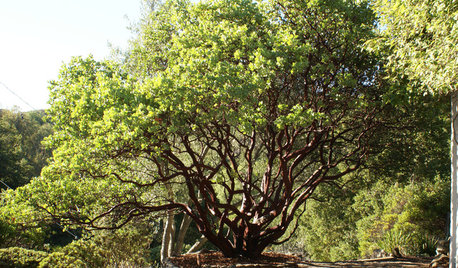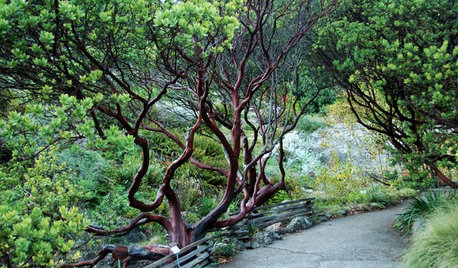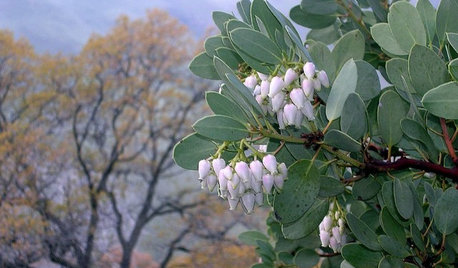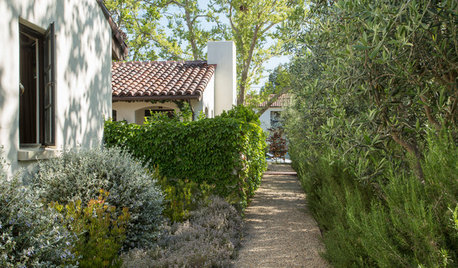What's wrong with our Manzanita 'Dr. Hurd'?
We have 2 Arctostaphylos 'Dr. Hurd' (Manzanita), each planted on either side of the front yard when it was re-landscaped in early 2010. We plan to train them into small trees.
We noticed yellowing of the lower leaves, so yesterday I pulled away the mulch and landscape fabric surrounding one of them and found BONE DRY cracked soil with a couple of roots on the very surface. We had a lot of good rain in winter and a cool, damp spring so we haven't been running the sprinklers in spite of a few hot days. The one I checked yesterday is planted on a slope. I've read they are tolerant of poor conditions, but they are not yet established and the yellow leaves with brown spots suggest they may be in trouble.
Believing it is under-watered, I gave it a good soaking yesterday.
Today, we will remove as much of the landscape fabric as possible. The fabric is literally stuck to the soil which is parched dry on the surface; I couldn't check below the surface because I could barely get a trowel into it. :( (Does it sound like I'm building a case against using landscape fabric around plants??? I am!)
After removing the fabric and soaking the surrounding soil, we'll apply a thick layer of bark mulch and give it a deep monthly watering with the hose. Are our Dr. Hurd trees in trouble, and is there anything else we need to do?
Here are two pictures showing the yellow leaves.
{{gwi:531335}}
{{gwi:531336}}
Comments (24)
Dick_Sonia
12 years agoI can't see anything wrong with it, actually. The only difference between deciduous plants and evergreen plants is that "evergreens" shed their leaves one at a time or in flushes rather than simultaneously in the fall. Spring -- when new foliage is being produced -- is a common time for flushes of senescent foliage to be shed. Bamboos, for example, are looking very ratty at this time of the year. In a few weeks, they will look great. Falling leaves aren't usually the result of excessive dryness. If the new growth starts to wilt, then I would worry.
chezron
12 years agoI think it was very smart of you to remove the landscape fabric. I also know that more manzanitas die of over watering than not and sometimes the symptoms of wilt can be caused by either. Your pictures look like nice healthy plants. Maybe leave them be for awhile now.
Related Professionals
New Bedford Landscape Architects & Landscape Designers · Ballenger Creek Landscape Architects & Landscape Designers · Beavercreek Landscape Architects & Landscape Designers · Jackson Landscape Contractors · Salem Landscape Contractors · Addison Landscape Contractors · Clark Landscape Contractors · Concord Landscape Contractors · Indio Landscape Contractors · Morrisville Landscape Contractors · Watertown Landscape Contractors · Fontana Swimming Pool Builders · Fairview Shores Window Contractors · Montgomery Village Window Contractors · Rio Linda Window ContractorsDan _Staley (5b Sunset 2B AHS 7)
12 years agoMee three. I don't see what the problem is. I would lean to it being established, but one more year of judicious watering often helps establishment - e.g 2-3-4 more waterings. Hard to say for sure without being there tho.
Dan
bahia
12 years agoI'd ask a couple of pertinent questions about them before being complacent that they are already established! From the time line provided and the size they now appear to be, I would guess that these were 15 gallon sized shrubs at planting? And how are they being watered? Drip irrigation emitters or a ring of soaker emitter line around them, conventional spray irrigation or by hand?
From what you have described, it sounds like they aren't getting any direct automatic irrigation at all. You might be able to expect a fall planted one gallon Manzanita to be fully established after two winters, but not a larger 15 gallon shrub that may only have been planted last spring.
Summer watering of Manzanitas at larger planting sizes will probably be required for the first two summers, on at least a monthly or perhaps twice a week basis if you are in a hotter inland area. I'd try to time your waterings so that you do it under cooler conditions; phytophthora root rot is very probable if you water when the soil is warm, and it will stay wet.
Without knowing what the landscape contractor/installer/designer was facing when planning your project, I wouldn't be so quick to write off the utility/necessity of using weed fabric. If you had lots of pernicious weeds that are difficult to control, had not taken the time to use more organic methods of watering to grow weeds, removing mechanically or by herbicide, and repeated several times prior to planting, weed fabric may have been the most expedient/practical method for controlling weeds. I find most garden clients don't really appreciate the prep work that will save time and labor down the road, and aren't often willing to spend the time/pay to do it right initially. Without knowing what your installer was facing, it can be a cheap shot to fault them for using weed fabric under mulch.
I'd suggest a deep soaking with a slow running hose occasionally for a couple of hours, every 3 to 4 weeks when it is cooler and foggy in your area, and hopefully they will be better established next spring to weather the summer. Losing older leaves is a normal late spring event, but if you are looking at poor winter into spring new growth, and wilted new foliage at this point, there is a problem. Also, yellowing leaves should not be continuous or over the whole plant, but just the lowest leaves on stems, which are the oldest foliage.
calistoga_al ca 15 usda 9
12 years agoI will admit it is a stretch to assume they are established after only one year in the ground. The description of the soil when the landscape fabric was removed led me to believe it was a clay based soil and was cracking from shrinking under a fabric that was in fact excluding air and moisture into the soil. In these conditions the roots will surface as what little air and moisture are available will be there. I also made the assumption that the plants were five gallon size, as it would be wasteful to buy 15 gallon size for this purpose, but then I am only used to spending my own money. From my own experience I have also learned not to use landscape fabric over plants roots as a weed barrier. Those roots will benefit so much from the mulch contact with the soil and the improvement of the soil structure as a result. I also recognize that a landscaper who makes a living preparing gardens for others makes decisions from a different view than a home gardener. Al
Dan _Staley (5b Sunset 2B AHS 7)
12 years agoI didn't look at the relative size of the plant. I agree that such large plants take longer to establish, and are problematic to begin with and should be babied to help them get over their shock. The water level should be monitored in its soil and a good soaking when needed is in order for at least this year.
Dan
jenn
Original Author12 years agoThanks, everyone. Here are the facts to help sort this out.
-- Manzanita 'Dr. Hurd' was planted in January 2010
-- Our soil is clay
-- It is planted on a slope, about 30 degrees, in full sun
-- I believe they were 5-gallon plants (DEFINITELY NOT 1-gal, and I'm fairly certain they weren't 15-gal size).
-- Their size at planting was approx. 3'
-- Current size is approx. 4'
-- Mature size could be 15'
-- All watering is done by sprinklers on a timer, for about 20 minutes.
-- A bark mulch was spread throughout the yard on top of the fabric.
-- Yellowing is on lower leaves only, and there is no wilting.I certainly would have approved of the long-term method of eradicating the weeds but I know our designer would not have agreed to that. He had others waiting to begin after ours. I appreciate the reasons he used the fabric; however we've done a lot of weeding anyway in other areas where the fabric was not used. I don't fault him for using it.
We bought some new bark mulch yesterday to apply around the Manazanita after I remove the landscape fabric.
There are at least 2 sprinkler heads nearby. Should we convert those heads to drip irrigation to avoid runoff and direct water to the roots?
Dan _Staley (5b Sunset 2B AHS 7)
12 years agoIf your timer is on already and the soil is dry, the fabric is not allowing water through. That will be problematic for all plants still needing to establish. I'd look at all your plants carefully, esp after the - AIUI - wet winter there, as you would think there would still be soil moisture in clay soil this time of year.
The issue with drip on that valve is the pressure will be too high for the drip heads & you'll never keep them on, or the hose will pop off. You need a separate valve for drip.
Dan
tressa
12 years agoHere is what I have learned from my own native garden in Temecula:
No landscape fabric on top of natives
No drip irrigation (important)
I have seen a lot of new growth on the natives due to our wet winter. They are now losing some one that excess growth by the browning and dropping of leaves. They do this naturally as summer (what summer? - LOL)) approaches in order to continue their drought resistance. Your Dr. Hurd looks great! I would be happy with it's growth....
Visit Calown.com and Las Pilitas Nursery for extensive info on natives. Greg Rubin, Calown, is a native landscape designer and takes us on a tour of his personal garden.jenn
Original Author12 years agoWe haven't run the sprinklers much this spring.... my husband doesn't remember how often (I work full time, usually gone when he does things like that).
We ran them yesterday for a while so I'll go out today and check the soil below the fabric.
I'm concerned about it being on the same watering system as all the other plants -- Salvia, Agapanthus, Daylily, Blue Fescue, Erodium, Texas Ranger... some more drought-tolerant than others. We could turn off the sprinklers near Dr. Hurd (also near Lavender and Rosemary) but not the others.
bahia
12 years agoI should have guessed that the original planting size was 5 gallon rather than 15 gallon, but the principle of longer period to get established still applies. In general, what you are doing will probably be fine. In general, sprinkler irrigation for manzanitas on the same circuit as the more water loving stuff isn't ideal, and manzanitas such as Dr. Hurd tend to get foliage diseases if they receive regular spray irrigation in warmer months. I would disagree that drip irrigation is not advisable for this Manzanita to get it established, but given that it is on the same circuit with the other plants you mention, it may be better to shut off heads at this area and hand water by a deep soaking once a month. Your photo of the manzanita doesn't look like it is on the steeper part of your slope, so the spray irrigation should be able to soak in fairly well. You could convert one or two heads to drip by capping one off, and adding a drip line with a pressure reducing device and y-filter at the riser, and laying out drip tubing line to the Texas Rangers, Rosemaries and Lavenders. You could also do a simple drip soaker line using 1/4 inch drip line with 12 inch on center emitters as a couple of concentric circles around the manzanitas, and install a shut off on the 1/4 inch line that you could open once a month, and leave closed the rest of the time. That would give you more flexibility in watering. Some weed fabric materials are much more permeable to water than others, and on a slope with spray irrigation, the run times may be too short to actually soak through the mulch and then wet the soil below, without causing run off. You may in fact have to run the system multiple times in sequence at shorter intervals with a break between to get effective wetting of the soil to any depth on a slope.
I generally prefer drip irrigation on slopes where feasible, because you can target a slower irrigation over a longer time without causing run off, and get water deeper into the soil. Most people just don't appreciate how long it can take to rewet a clay based soil once it has dried out. A 20 minute irrigation cycle on a 30% slope typically won't wet more than an inch or two deep. Get yourself a soil probe to check wetting depths, and adjust your irrigation run times as necessary.
Dan _Staley (5b Sunset 2B AHS 7)
12 years agoYou could convert one or two heads to drip by capping one off, and adding a drip line with a pressure reducing device and y-filter at the riser, and laying out drip tubing line to the Texas Rangers, Rosemaries and Lavenders.
You could but how much water are you going to deliver? You want your drip heads to run longer than spray, as they are rated at delivering gph, whereas spray are at gpm.
Dan
jenn
Original Author12 years agoThank you for the additional responses.
We bought a new 75' garden hose to extend from the house to Dr. Hurd so we can give it long slow drip irrigation during the dry season until it is established (and occasionally after it is). Hubby seems to agree with capping off the sprinkler directly in front of it.
chendri887_yahoo_com
12 years agoThis is a great discussion! I've got several different species of manzanita planted on my backyard slope. Like you (I think), I planted most of them last fall (2010), and didn't water them at all (due to the rain we received last fall, winter and spring), until recently. My St. Helena hybrid looked like your Dr. Hurd, with yellowing leaves. After a couple of long waterings though, it seems to have perked up. My Louis Edmunds also had some of these symptoms, which went away after a long watering.
As to how much to water during the hot summer during the first year or two, I am still confused about that. Some people seem to suggest a great deal of water, others not so much. This discussion seems to mirror the information online and what I've gotten at nursuries such as Las Pilitas and Tree of Life. I guess its just a tree by tree, slope by slope, climate by climate thing, with no one having a clear answer.
jenn
Original Author12 years agoI'm sad to report that Dr. Hurd is not recovering. I gave it one long/slow/deep watering when I posted this thread, and removed the landscape fabric after which it continued turning yellow, then brown, with no water since -- even turning off the sprinkler in front of it. We're planning to dig it up, at which time I'll examine the roots --- perhaps they're wrapped around the root ball and never had a chance. Perhaps the mulch kept the soil (clay) too moist, so I brushed it away today. The other one, NOT planted on a slope, is still doing very well.
RIP, Dr. Hurd... :-(
{{gwi:531337}}
calistoga_al ca 15 usda 9
12 years agoAnytime I have a shrub looking sick all over, I dig down around the roots. Nearly always the problem will be apparent, such as a drainage problem, or gopher damage, maybe simple compaction. Al
jenn
Original Author12 years agoWe haven't inspected yet... been busy with other things. Just this morning we talked about doing that and purchasing a replacement for Fall planting.
I'm certain it's a goner now.... all the leaves are a beautiful golden brown, no green whatsoever. :(
I'll report back here when we find out something.
jenn
Original Author12 years agoWe finally removed it today. Hubby said the shovel went in so easily, he could have pushed it all the way in with his hands alone. The soil around the roots was very loose and the roots were not well in contact with the soil around them.
We'll replace it with a 15-gal plant in November when the weather is cooler, making sure it is seated well in the hole and the soil firmed around the roots.
I must add that even the dead form of this tree is beautiful -- the flaky brown bark and russet-orange (dead) leaves made it look like a plant covered in the glory of Fall colors. :)
bahia
12 years agoI'd suggest that a 5 gallon size replacement might establish better, and avoid having weed fabric within 3 feet of the trunk. I'd suspect that the soil stayed too wet with warm soil temps led to root fungal attack. You may want to remove existing soil to minimize chance of reinfection if planting in the same spot.
EarthsInternet
10 years agoFirst off, I would never plant a Manzanita which was re-potted into a large container like 5 gallon or above. One gallon is sufficient. With Cal-Natives I've always found one gallon to be superior to anything larger. In my experience they will often surpass anything larger in the long run. I understand the reasons of course, people want instant landscape.
I also never soil amend, although I may in the top few inches of clay soils. I also would never plant without inoculation of mycorrhizal fungi. Like many other similar type acid soil plants Arbutus (Madrone) or plants like Blueberries, I'm not sure Manzanita has the same potential for fine root hairs like other plants, hence the mycorrhizal associations are the only thing that facilitates water and nutrient uptake. Most of my experience is to pattern exactly what takes place out in Nature.
I also tend to agree that the plant you had may have been lovingly overwatered to death. Especially if the soil was a heavy clay as you stated, it may have created an anaerobic underground system where roots rotted for lack of oxygen penetration into the clay, hence, lack of an aerobic system. Mycorrhizae would have helped establish with very little watering. I've been successful with every manzanita I've dealt with by this replication. ground barriers too are something I never use. Mulch is good enough for me, especially bark mulch as they suppress weeds, which is the main purpose of the barrier in the first place.
Mike Amaranthus of Mycorrhizal Applications Inc has an excellent mycorrhizal blend which works beautifully on manzanita roots. I've written very much on manzanitas I've planted and cared for at home and at work as a landscape supervisor. Some element of neglect is a good thing in this case. I'll provide a link to my Mum's Island Manzanita "Canyon Sparkle" which shouldn't even survive in the hot climate of El Cajon California according to all the expert literature. Replicate Nature and you'll be surprised at how little many experts know.
Keep In the post below, keep in mind, this Manzanita receives no water EVER beyond winter rainy season. Hope this is helpful. Well, I tried posting the link but the system won't let me, I have no idea why. Maybe I'll figure it out later. Sorry
OregonGrape
10 years agoNever amend the soil near a manzanita. The nutrients will cause the mycorrhiza to detach from the roots, leaving the plants open to attack by pathogens. Manzanitas strongly associate with the ectomycorrhiza in the first four or so inches of the soil.
Unless your house is in a newer subdivision, where the top of the soil has been recently scraped away and then bulldozed back into place, there is likely mycorrhiza in your soil. This is particularly true if you have other plants that have mycorrhizal associations. If you have several of these plants in the ground, you may have a mycorrhizal "grid" in your soil. I took out a couple of diseased Myrica californicas and planted a Howard McMinn manzanita in between the two ground-down stumps back in March. The Howard McMinn grew from the size of my hand to 22" x 30" in seven months. That said, I don't see how inoculating one's soil with more mycorrhiza would hurt.
The best way to enhance and maintain the mycorrhiza population in your soil is to mulch heavily with bark from plants that have mycorrhizal associations. The bark provides nutrients to the fungi. Oak, pine, fir, and Doug fir bark mulch all work really well. Spread a 3" deep layer in a 3' diameter around where you're going to plant. Water heavily a few times over the course of a couple of months, and your soil should have a strong mycorrhizal population. Add fresh mulch every spring.
It's also important to note that it is possible to under-water a manzanita in its first year (I've done it). Manzanitas planted in the spring will probably need water every 10 days or so during that first summer. From June-October, stick your finger a few inches down into the soil. If it's dry, water it (around the perimeter of the root ball). If the soil is moist, check again the following week.
In addition, some ESTABLISHED manzanitas do best with at least some summer water. Some of the A. hookeri cultivars do best with water every 10 days or so. On the other side of the spectrum, A. glauca Big Berry prefers no summer water. Some species, such as A. densiflora, have cultivars with very different water tolerances (Howard McMinn can take once-a-week water, while Sentinel doesn't like more than once-a-month water). Be sure to water in the early morning, when it's cool outside. Watering at 2 pm when it's 102 degrees will promote root rot!
Below is a link that contains water requirements.
Here is a link that might be useful: Manzanita requirements
paula82
8 years agoWe purchased a huge Dr. Hurd in a 40" pot. When we planted it in our front garden in languished. Then when the drought started, it has come into it's own, even blooming. I would say that it's the MOST drought tolerant plant in our yards.















calistoga_al ca 15 usda 9